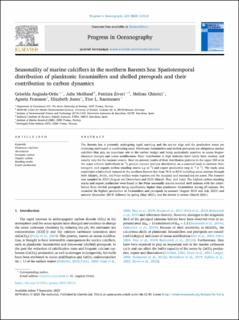Seasonality of marine calcifiers in the northern Barents Sea: Spatiotemporal distribution of planktonic foraminifers and shelled pteropods and their contribution to carbon dynamics
Ortiz, Griselda Anglada; Meilland, Julie; Ziveri, Patrizia; Chierici, Melissa; Fransson, Agneta; Jones, Elizabeth Marie; Rasmussen, Tine Lander
Peer reviewed, Journal article
Published version
Permanent lenke
https://hdl.handle.net/11250/3090371Utgivelsesdato
2023Metadata
Vis full innførselSamlinger
- Articles [3009]
- Publikasjoner fra CRIStin [3056]
Originalversjon
10.1016/j.pocean.2023.103121Sammendrag
The Barents Sea is presently undergoing rapid warming and the sea-ice edge and the productive zones are retreating northward at accelerating rates. Planktonic foraminifers and shelled pteropods are ubiquitous marine calcifiers that play an important role in the carbon budget and being particularly sensitive to ocean biogeochemical changes and ocean acidification. Their distribution at high latitudes have rarely been studied, and usually only for the summer season. Here we present results of their distribution patterns in the upper 300 m in the water column (individuals m−3), protein content and size distribution on a seasonal basis to estimate their inorganic and organic carbon standing stocks (µg m−3) and export production (mg m−2 d−1). The study area constitutes a latitudinal transect in the northern Barents Sea from 76˚ N to 82˚ N including seven stations through both Atlantic, Arctic, and Polar surface water regimes and the marginal and seasonal sea-ice zones. The transect was sampled in 2019 (August and December) and 2021 (March, May, and July). The highest carbon standing stocks and export production were found at the Polar seasonally sea-ice covered shelf stations with the contribution from shelled pteropods being significantly higher than planktonic foraminifers during all seasons. We recorded the highest production of foraminifers and pteropods in summer (August 2019 and July 2021) and autumn (December 2019) followed by spring (May 2021), and the lowest in winter (March 2021). Seasonality of marine calcifiers in the northern Barents Sea: Spatiotemporal distribution of planktonic foraminifers and shelled pteropods and their contribution to carbon dynamics
